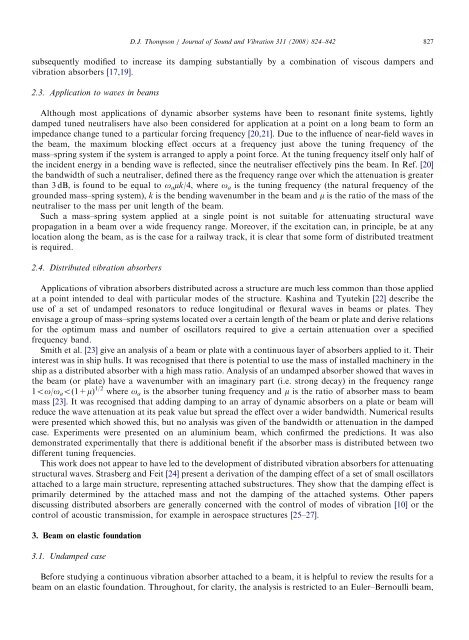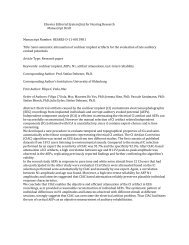A continuous damped vibration absorber to reduce broad-band ...
A continuous damped vibration absorber to reduce broad-band ...
A continuous damped vibration absorber to reduce broad-band ...
You also want an ePaper? Increase the reach of your titles
YUMPU automatically turns print PDFs into web optimized ePapers that Google loves.
subsequently modified <strong>to</strong> increase its damping substantially by a combination of viscous dampers and<br />
<strong>vibration</strong> <strong>absorber</strong>s [17,19].<br />
2.3. Application <strong>to</strong> waves in beams<br />
Although most applications of dynamic <strong>absorber</strong> systems have been <strong>to</strong> resonant finite systems, lightly<br />
<strong>damped</strong> tuned neutralisers have also been considered for application at a point on a long beam <strong>to</strong> form an<br />
impedance change tuned <strong>to</strong> a particular forcing frequency [20,21]. Due <strong>to</strong> the influence of near-field waves in<br />
the beam, the maximum blocking effect occurs at a frequency just above the tuning frequency of the<br />
mass–spring system if the system is arranged <strong>to</strong> apply a point force. At the tuning frequency itself only half of<br />
the incident energy in a bending wave is reflected, since the neutraliser effectively pins the beam. In Ref. [20]<br />
the <strong>band</strong>width of such a neutraliser, defined there as the frequency range over which the attenuation is greater<br />
than 3 dB, is found <strong>to</strong> be equal <strong>to</strong> oamk/4, where oa is the tuning frequency (the natural frequency of the<br />
grounded mass–spring system), k is the bending wavenumber in the beam and m is the ratio of the mass of the<br />
neutraliser <strong>to</strong> the mass per unit length of the beam.<br />
Such a mass–spring system applied at a single point is not suitable for attenuating structural wave<br />
propagation in a beam over a wide frequency range. Moreover, if the excitation can, in principle, be at any<br />
location along the beam, as is the case for a railway track, it is clear that some form of distributed treatment<br />
is required.<br />
2.4. Distributed <strong>vibration</strong> <strong>absorber</strong>s<br />
Applications of <strong>vibration</strong> <strong>absorber</strong>s distributed across a structure are much less common than those applied<br />
at a point intended <strong>to</strong> deal with particular modes of the structure. Kashina and Tyutekin [22] describe the<br />
use of a set of un<strong>damped</strong> resona<strong>to</strong>rs <strong>to</strong> <strong>reduce</strong> longitudinal or flexural waves in beams or plates. They<br />
envisage a group of mass–spring systems located over a certain length of the beam or plate and derive relations<br />
for the optimum mass and number of oscilla<strong>to</strong>rs required <strong>to</strong> give a certain attenuation over a specified<br />
frequency <strong>band</strong>.<br />
Smith et al. [23] give an analysis of a beam or plate with a <strong>continuous</strong> layer of <strong>absorber</strong>s applied <strong>to</strong> it. Their<br />
interest was in ship hulls. It was recognised that there is potential <strong>to</strong> use the mass of installed machinery in the<br />
ship as a distributed <strong>absorber</strong> with a high mass ratio. Analysis of an un<strong>damped</strong> <strong>absorber</strong> showed that waves in<br />
the beam (or plate) have a wavenumber with an imaginary part (i.e. strong decay) in the frequency range<br />
1oo/oao(1+m) 1/2 where oa is the <strong>absorber</strong> tuning frequency and m is the ratio of <strong>absorber</strong> mass <strong>to</strong> beam<br />
mass [23]. It was recognised that adding damping <strong>to</strong> an array of dynamic <strong>absorber</strong>s on a plate or beam will<br />
<strong>reduce</strong> the wave attenuation at its peak value but spread the effect over a wider <strong>band</strong>width. Numerical results<br />
were presented which showed this, but no analysis was given of the <strong>band</strong>width or attenuation in the <strong>damped</strong><br />
case. Experiments were presented on an aluminium beam, which confirmed the predictions. It was also<br />
demonstrated experimentally that there is additional benefit if the <strong>absorber</strong> mass is distributed between two<br />
different tuning frequencies.<br />
This work does not appear <strong>to</strong> have led <strong>to</strong> the development of distributed <strong>vibration</strong> <strong>absorber</strong>s for attenuating<br />
structural waves. Strasberg and Feit [24] present a derivation of the damping effect of a set of small oscilla<strong>to</strong>rs<br />
attached <strong>to</strong> a large main structure, representing attached substructures. They show that the damping effect is<br />
primarily determined by the attached mass and not the damping of the attached systems. Other papers<br />
discussing distributed <strong>absorber</strong>s are generally concerned with the control of modes of <strong>vibration</strong> [10] or the<br />
control of acoustic transmission, for example in aerospace structures [25–27].<br />
3. Beam on elastic foundation<br />
3.1. Un<strong>damped</strong> case<br />
ARTICLE IN PRESS<br />
D.J. Thompson / Journal of Sound and Vibration 311 (2008) 824–842 827<br />
Before studying a <strong>continuous</strong> <strong>vibration</strong> <strong>absorber</strong> attached <strong>to</strong> a beam, it is helpful <strong>to</strong> review the results for a<br />
beam on an elastic foundation. Throughout, for clarity, the analysis is restricted <strong>to</strong> an Euler–Bernoulli beam,
















